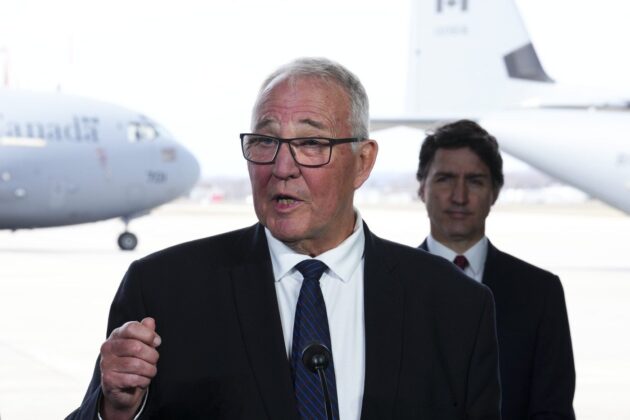
What’s in Canada’s new ‘Our North, Strong and Free’ defence policy
By The Canadian Press
News Securing the Nation Canadian military defence military policy
Prime Minister Justin Trudeau and National Defence Minister Bill Blair hold a press conference regarding Canada’s new defence policy at CFB Trenton, in Trenton, Ont., Monday, April 8, 2024. In all, the “Our North, Strong and Free” defence policy will allocate another $73 billion over the next 20 years. THE CANADIAN PRESS/Sean Kilpatrick
Canada’s military is set to take a bigger role in the North over the next two decades as climate change and increasingly aggressive foes threaten Arctic sovereignty.
In all, the “Our North, Strong and Free” defence policy will allocate another $73 billion over the next 20 years.
Here are some of the details of how that money will be spent:
$9.5 billion to ramp up production of new artillery ammunition in Canada and buy up rounds for our own stockpile.
$18.4 billion for new tactical helicopters to replace the CH-146 Griffon fleet.
$2.7 billion to purchase long-range missiles for the Army.
$1.4 billion for specialized maritime sensors that can detect missiles, underwater systems, ships and submarines.
$307 million on airborne early warning aircraft.
$2.8 billion for a new Canadian Armed Forces Cyber Command.
$5.5 billion to buy a comprehensive worldwide satellite communication capability that ensures adversaries can’t jam or disrupt communications.
$9 billion for critical updates to existing equipment over the next 20 years.
$9.9 billion to extend the life of the Halifax-class frigates and at-sea replenishment capabilities.
The government is also committing to “explore options” for several new capabilities, including:
— Ground-based air defence systems to protect against drones, missiles and artillery.
— Long-range air and sea missiles.
— Upgraded or new battle tanks and light armoured vehicles.
— Submarines, which will be conventionally powered and capable of performing under the ice.
— Surveillance and strike drones, along with counter-drone capabilities.
— All-terrain vehicles that are adapted to the ice, snow and tundra.
— Ways to enable the new Arctic and offshore patrol ships to operate helicopters at sea.
This report by The Canadian Press was first published April 8, 2024.
Print this page
Advertisement
- Federal government used AI in hundreds of initiatives, new research database shows
- Nova Scotia town seeking novel approach to dealing with unruly university students
Leave a Reply